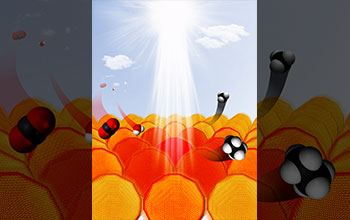Multimedia Gallery
2-electron chemical reactions using light energy and gold
Under the right conditions, gold nanoparticles absorb light and transfer electrons to other reactants. This process can be used to convert carbon dioxide and water into hydrocarbons. In this graphic, carbon atoms are black, oxygen atoms are red and hydrogen atoms are white.
More about this image
Scientists are one step closer to building a carbon-recycling system that can harvest solar energy to efficiently convert carbon dioxide (CO2) and water into liquid fuels. By optimizing many parts of the system, the researchers say, they can now drive two-electron chemical reactions, a substantial advance over one-electron reactions, which are energy inefficient.
According to University of Illinois chemistry professor Prashant Jain, who led the research, the research will aid those hoping to find a way to convert excess CO2 in the atmosphere into useful energy sources. However, while the new findings represent an important step forward, Jain says much more work must be done before this technology is ready to be employed and scaled up to meet current challenges.
The research was supported in part by the National Science Foundation.
Read more about this research in the University of Illinois news story Team achieves two-electron chemical reactions using light energy, gold. (Date image taken: 2018; date originally posted to NSF Multimedia Gallery: Aug. 22, 2018)
Credit: Graphic by Sungju Yu; Jain Lab; University of Illinois
Images and other media in the National Science Foundation Multimedia Gallery are available for use in print and electronic material by NSF employees, members of the media, university staff, teachers and the general public. All media in the gallery are intended for personal, educational and nonprofit/non-commercial use only.
Images credited to the National Science Foundation, a federal agency, are in the public domain. The images were created by employees of the United States Government as part of their official duties or prepared by contractors as "works for hire" for NSF. You may freely use NSF-credited images and, at your discretion, credit NSF with a "Courtesy: National Science Foundation" notation.
Additional information about general usage can be found in Conditions.
Also Available:
Download the high-resolution JPG version of the image. (3.6 MB)
Use your mouse to right-click (Mac users may need to Ctrl-click) the link above and choose the option that will save the file or target to your computer.

